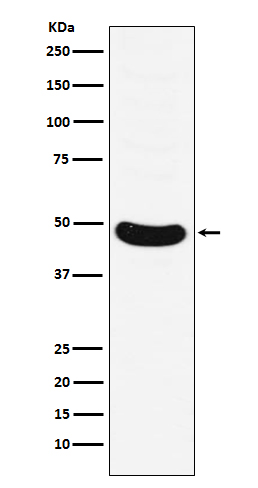Anti-HB9/HLXB9 Monoclonal Antibody
- SPECIFICATION
- CITATIONS
- PROTOCOLS
- BACKGROUND

Application
| WB, IP |
|---|---|
| Primary Accession | P50219 |
| Host | Rabbit |
| Isotype | Rabbit IgG |
| Reactivity | Human, Mouse |
| Clonality | Monoclonal |
| Format | Liquid |
| Description | Anti-HB9/HLXB9 Monoclonal Antibody . Tested in WB, IP applications. This antibody reacts with Human, Mouse. |
| Gene ID | 3110 |
|---|---|
| Other Names | Motor neuron and pancreas homeobox protein 1, Homeobox protein HB9, MNX1, HLXB9 |
| Calculated MW | 40569 Da |
| Application Details | WB 1:500-1:2000 IP 1:50 |
| Contents | Rabbit IgG in phosphate buffered saline, pH 7.4, 150mM NaCl, 0.02% sodium azide and 50% glycerol, 0.4-0.5mg/ml BSA. |
| Clone Names | Clone: ACIE-13 |
| Immunogen | A synthesized peptide derived from human HB9/HLXB9 |
| Purification | Affinity-chromatography |
| Storage | Store at -20°C for one year. For short term storage and frequent use, store at 4°C for up to one month. Avoid repeated freeze-thaw cycles. |
| Name | MNX1 |
|---|---|
| Synonyms | HLXB9 |
| Function | Transcription factor (By similarity). Recognizes and binds to the regulatory elements of target genes, such as visual system homeobox CHX10, negatively modulating transcription (By similarity). Plays a role in establishing motor neuron identity, in concert with LIM domain transcription factor LMO4 (By similarity). Involved in negatively modulating transcription of interneuron genes in motor neurons, acting, at least in part, by blocking regulatory sequence interactions of the ISL1-LHX3 complex (By similarity). Involved in pancreas development and function; may play a role in pancreatic cell fate specification (By similarity). |
| Cellular Location | Nucleus. |
| Tissue Location | Expressed in lymphoid and pancreatic tissues. |

Thousands of laboratories across the world have published research that depended on the performance of antibodies from Abcepta to advance their research. Check out links to articles that cite our products in major peer-reviewed journals, organized by research category.
info@abcepta.com, and receive a free "I Love Antibodies" mug.
Provided below are standard protocols that you may find useful for product applications.
Background
Putative transcription factor involved in pancreas development and function.
If you have used an Abcepta product and would like to share how it has performed, please click on the "Submit Review" button and provide the requested information. Our staff will examine and post your review and contact you if needed.
If you have any additional inquiries please email technical services at tech@abcepta.com.













 Foundational characteristics of cancer include proliferation, angiogenesis, migration, evasion of apoptosis, and cellular immortality. Find key markers for these cellular processes and antibodies to detect them.
Foundational characteristics of cancer include proliferation, angiogenesis, migration, evasion of apoptosis, and cellular immortality. Find key markers for these cellular processes and antibodies to detect them. The SUMOplot™ Analysis Program predicts and scores sumoylation sites in your protein. SUMOylation is a post-translational modification involved in various cellular processes, such as nuclear-cytosolic transport, transcriptional regulation, apoptosis, protein stability, response to stress, and progression through the cell cycle.
The SUMOplot™ Analysis Program predicts and scores sumoylation sites in your protein. SUMOylation is a post-translational modification involved in various cellular processes, such as nuclear-cytosolic transport, transcriptional regulation, apoptosis, protein stability, response to stress, and progression through the cell cycle. The Autophagy Receptor Motif Plotter predicts and scores autophagy receptor binding sites in your protein. Identifying proteins connected to this pathway is critical to understanding the role of autophagy in physiological as well as pathological processes such as development, differentiation, neurodegenerative diseases, stress, infection, and cancer.
The Autophagy Receptor Motif Plotter predicts and scores autophagy receptor binding sites in your protein. Identifying proteins connected to this pathway is critical to understanding the role of autophagy in physiological as well as pathological processes such as development, differentiation, neurodegenerative diseases, stress, infection, and cancer.


